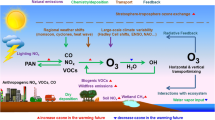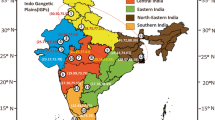Abstract
Northwest China is recognized as a main source and a major transport channel of dust aerosols in East Asia. With a fragile ecological environment, this region is quite sensitive to global climate change. Based on the satellite-derived aerosol three-dimensional distribution, the direct radiative effects of dust aerosols over Northwest China are evaluated. Aerosols over Northwest China are mainly distributed in the Tarim Basin, Junggar Basin, Gobi Desert, and Loess Plateau. The aerosol extinction coefficients are greater than 0.36 km−1 over the Tarim Basin and 0.16 km−1 over the Gobi Desert and Loess Plateau, decreasing with height. Aerosols over Northwest China are mainly composed of pure dust and polluted dust. These dust aerosols can modify the horizontal temperature gradient, vertical thermodynamic structure, and diurnal temperature range by absorbing and scattering shortwave radiation and emitting longwave radiation. For the column atmosphere, the radiative effect of dust aerosols shows heating effect of approximately 0.3 K day−1 during the daytime and cooling effect of approximately −0.4 K day−1 at night. In the vertical direction, dust aerosols can heat up the lower atmosphere (0.5–1.5 K day−1) and cool down the upper atmosphere (about −1.0 K day−1) during the daytime, while they cool down the lower atmosphere (−3 to −1.5 K day−1) and heat up the upper atmosphere (1–1.5 K day−1) at night. There are also significant lateral and vertical variations in the dust radiative effects corresponding to their spatial distributions. This study provides some scientific basis for reducing uncertainty in the investigation of aerosol radiative effects and provides observation evidence for simulation studies.
Similar content being viewed by others
References
Adams, A. M., J. M. Prospero, and C. D. Zhang, 2012: CALIPSO-derived three-dimensional structure of aerosol over the Atlantic basin and adjacent continents. J. Climate, 25, 6862–6879, doi: https://doi.org/10.1175/jcli-d-11-00672.1.
Chen, Q., Y. Yin, L. J. Jin, et al., 2011: The effect of aerosol layers on convective cloud microphysics and precipitation. Atmos. Res., 101, 327–340, doi: https://doi.org/10.1016/j.atmorees.2011.03.007.
Chen, S. Y., J. P. Huang, C. Zhao, et al., 2013: Modeling the transport and radiative forcing of Taklimakan dust over the Tibetan Plateau: A case study in the summer of 2006. J. Geophys. Res. Atmos., 118, 797–812, doi: https://doi.org/10.1002/jgrd.50122.
Chen, S. Y., J. P. Huang, J. X. Li, et al., 2017: Comparison of dust emissions, transport, and deposition between the Taklimakan Desert and Gobi Desert from 2007 to 2011. Sci. China Earth Sci., 60, 1338–1355, doi: https://doi.org/10.1007/s11430-016-9051-0.
Fan, J. W., D. Rosenfeld, Y. Yang, et al., 2015: Substantial contribution of anthropogenic air pollution to catastrophic floods in Southwest China. Geophys. Res. Lett., 42, 6066–6075, doi: https://doi.org/10.1002/2015gl064479.
Henderson, D. S., T. L’Ecuyer, G. Stephens, et al., 2013: A multisensor perspective on the radiative impacts of clouds and aerosols. J. Appl. Meteor. Climatol., 52, 853–871, doi: https://doi.org/10.1175/jamc-d-12-025.1.
Huang, J., Q. Fu, J. Su, et al., 2009: Taklimakan dust aerosol radiative heating derived from CALIPSO observations using the Fu-Liou radiation model with CERES constraints. Atmos. Chem. Phys., 9, 4011–4021, doi: https://doi.org/10.5194/acp-9-4011-2009.
Huang, J., P. Minnis, H. Yan, et al., 2010: Dust aerosol effect on semi-arid climate over Northwest China detected from Atrain satellite measurements. Atmos. Chem. Phys., 10, 6863–6872, doi: https://doi.org/10.5194/acp-10-6863-2010.
Huang, J. P., T. H. Wang, W. C. Wang, et al., 2014: Climate effects of dust aerosols over east Asian arid and semiarid regions. J. Geophys. Res. Atmos., 119, 11,398–11,416, doi: https://doi.org/10.1002/2014JD021796.
Huang, J. P., J. R. Ma, X. D. Guan, et al., 2019: Progress in semi-arid climate change studies in China. Adv. Atmos. Sci., 36, 922–937, doi: https://doi.org/10.1007/s00376-018-8200-9.
Jia, R., J. Li, Q. Z. Zhu, et al., 2021: Three-dimensional distribution and formation causes of aerosols over Northwest China. J. Desert Res., 41, 34–43. (in Chinese)
Jiang, D. B., M. F. Su, R. Q. Wei, et al., 2009: Variation and projection of drought and wet conditions in Xinjiang. Chinese J. Atmos. Sci., 33, 90–98, doi: https://doi.org/10.3878/j.issn.1006-9895.2009.01.08. (in Chinese)
Jiang, J. H., H. Su, L. Huang, et al., 2018: Contrasting effects on deep convective clouds by different types of aerosols. Nat. Commun., 9, 3874, doi: https://doi.org/10.1038/s41467-018-06280-4.
Kahn, R. A., D. L. Nelson, M. J. Garay, et al., 2009: MISR aerosol product attributes and statistical comparisons with MODIS. IEEE Trans. Geosci. Remote Sens., 47, 4095–4114, doi: https://doi.org/10.1109/tgrs.2009.2023115.
Kang, S. C., Y. W. Xu, Q. L. You, et al., 2010: Review of climate and cryospheric change in the Tibetan Plateau. Environ. Res. Lett., 5, 015101, doi: https://doi.org/10.1088/1748-9326/5/1/015101.
Kawecki, S., G. M. Henebry, A. L. Steiner, 2016: Effects of urban plume aerosols on a mesoscale convective system. J. Atmos. Sci., 73, 4641–4660, doi: https://doi.org/10.1175/jas-d-16-0084.1.
Lau, K. M., M. K. Kim, and K. M. Kim., 2006: Asian summer monsoon anomalies induced by aerosol direct forcing: The role of the Tibetan Plateau. Climate Dyn., 26, 855–864, doi: https://doi.org/10.1007/s00382-006-0114-z.
Lau, W. K. M., M. K. Kim, K. M. Kim, et al., 2010: Enhanced surface warming and accelerated snow melt in the Himalayas and Tibetan Plateau induced by absorbing aerosols. Environ. Res. Lett., 5, 025204, doi: https://doi.org/10.1088/1748-9326/5/2/025204.
Lee, W. L., K. N. Liou, C. He, et al., 2017: Impact of absorbing aerosol deposition on snow albedo reduction over the southern Tibetan Plateau based on satellite observations. Theor. Appl. Climatol., 129, 1373–1382, doi: https://doi.org/10.1007/s00704-016-1860-4.
Lee, W. S., R. L. Bhawar, M. K. Kim, et al., 2013: Study of aerosol effect on accelerated snow melting over the Tibetan Plateau during boreal spring. Atmos. Environ., 75, 113–122, doi: https://doi.org/10.1016/j.atmosenv.2013.04.004.
Ma, Y. N., J. Y. Xin, W. Y. Zhang, et al., 2021: Uncertainties of simulated aerosol direct radiative effect induced by aerosol chemical components: A measurement-based perspective from urban-forest transition region in East China. J. Geophys. Res. Atmos., 126, e2020JD033688, doi: https://doi.org/10.1029/2020jd033688.
Ma, Z. G., C. B. Fu, Q. Yang, et al., 2018: Drying trend in Northern China and its shift during 1951–2016. Chinese J. Atmos. Sci., 42, 951–961, doi: https://doi.org/10.3878/j.issn.1006-9895.1802.18110. (in Chinese)
Paukert, M., C. Hoose, and M. Simmel, 2017: Redistribution of ice nuclei between cloud and rain droplets: Parameterization and application to deep convective clouds. J. Adv. Model. Earth Syst., 9, 514–535, doi: https://doi.org/10.1002/2016ms000841.
Samset, B. H., and G. Myhre, 2011: Vertical dependence of black carbon, sulphate and biomass burning aerosol radiative forcing. Geophys. Res. Lett., 38, L24802, doi: https://doi.org/10.1299/2011gl049697.
Samset, B. H., G. Myhre, M. Schulz, et al., 2013: Black carbon vertical profiles strongly affect its radiative forcing uncertainty. Atmos. Chem. Phys., 1, 2423–2434, doi: https://doi.org/10.5194/acp-13-2423-2013.
Shen, J., Y. H. Li, and X. W. Zhu, 2010: Influence of climate and enviroment change on dust storm in Northwest China. J. Arid Meteor., 28, 467–474, doi: https://doi.org/10.3969/j.issn.1006-7639.2010.04.016. (in Chinese)
Shi, T. L., J. C. Cui, Y. Chen, et al., 2021: Enhanced light absorption and reduced snow albedo due to internally mixed mineral dust in grains of snow. Atmos. Chem. Phys., 21, 6035–6051, doi: https://doi.org/10.5194/acp-21-6035-2021.
Soldatenko, S., 2020: Estimating the effect of radiative feedback uncertainties on climate response to changes in the concentration of stratospheric aerosols. Atmosphere, 11, 654, doi: https://doi.org/10.3390/atmos11060654.
Wang, X. M., D. W. Cai, S. Y. Chen, et al., 2021: Spatio-temporal trends of dust emissions triggered by desertification in China. CATENA, 200, 105160, doi: https://doi.org/10.1016/j.catena.2021.105160.
Wang, Y. C., and C. Y. Zhao, 2001: Study in desert-oasis ecological fragile zone. Arid Land Geogr., 24, 182–188, doi: https://doi.org/10.3321/j.issn:1000-6060.2001.02.017. (in Chinese)
Wei, K., and L. Wang, 2013: Reexamination of the aridity conditions in arid Northwestern China for the last decade. J. Climate, 26, 9594–9602, doi: https://doi.org/10.1175/jcli-d-12-00605.1.
Wu, D. Y., J. Liu, T. S. Wang, et al., 2021: Applying a dust index over North China and evaluating the contribution of potential factors to its distribution. Atmos. Res., 254, 105515, doi: https://doi.org/10.1016/j.atmosres.2021.105515.
Yang, J. H., K. Q. Duan, S. C. Kang, et al., 2017: Potential feedback between aerosols and meteorological conditions in a heavy pollution event over the Tibetan Plateau and Indo-Gangetic Plain. Climate Dyn., 48, 2901–2917, doi: https://doi.org/10.1007/s00382-016-3240-2.
Young, S. A., M. A. Vaughan, A. Garnier, et al., 2018: Extinction and optical depth retrievals for CALIPSO’s version 4 data release. Atmos. Meas. Tech., 11, 5701–5727, doi: https://doi.org/10.5194/amt-11-5701-2018.
Yuan, T. G., J. P. Huang, J. H. Cao, et al., 2021: Indian dust-rain storm: Possible influences of dust ice nuclei on deep convective clouds. Sci. Total Environ., 779, 146439, doi: https://doi.org/10.1016/j.scitotenv.2021.146439.
Zarzycki, C. M., and T. C. Bond, 2010: How much can the vertical distribution of black carbon affect its global direct radiative forcing? Geophys. Res. Lett., 37, L20807, doi: https://doi.org/10.1029/2010gl044555.
Zhang, C., S. L. Li, F. F. Luo, et al., 2019: The global warming hiatus has faded away: An analysis of 2014–2016 global surface air temperatures. Int. J. Climatol., 39, 4853–1868, doi: https://doi.org/10.1002/joc.6114.
Zhang, Q., Z. Y. Deng, Y. D. Zhao, et al., 2008: The impacts of global climatic change on the agriculture in Northwest China. Acta Ecol. Sinica, 28, 1210–1218, doi: https://doi.org/10.3321/j.issn:1000-0933.2008.03.037. (in Chinese)
Zhang, Q., C. J. Zhang, H. Z. Bai, et al., 2010: New development of climate change in Northwest China and its impact on arid environment. J. Arid Meteor., 28, 1–7, doi: https://doi.org/10.3969/j.issn.1006-7639.2010.01.001. (in Chinese)
Zhao, D. S., and S. H. Wu, 2013: Responses of vulnerability for natural ecosystem to climate change in China. Acta Geogr. Sinica, 68, 602–610, doi: https://doi.org/10.11821/xb201305003. (in Chinese)
Acknowledgments
We are very grateful to the anonymous reviewers for their helpful comments. The CALIPSO, CloudSat, and MISR data were obtained from the NASA Langley Research Center Atmospheric Sciences Data Center. The authors gratefully acknowledge their efforts in making these data available online.
Author information
Authors and Affiliations
Corresponding author
Additional information
Supported by the Gansu Provincial Special Fund for Scientific and Technological Innovation and Development (2019ZX-06), Fundamental Research Funds for the Central Universities (lzujbky-2020-kb31), and Meteorological Science and Technology Research Project of Shandong Meteorological Bureau (2019sdqxm14).
Rights and permissions
About this article
Cite this article
Jia, R., Liu, Y., Li, Y. et al. Direct Radiative Effects of Dust Aerosols over Northwest China Revealed by Satellite-Derived Aerosol Three-Dimensional Distribution. J Meteorol Res 36, 767–778 (2022). https://doi.org/10.1007/s13351-022-1212-5
Received:
Accepted:
Published:
Issue Date:
DOI: https://doi.org/10.1007/s13351-022-1212-5




